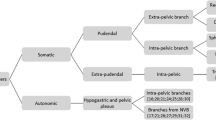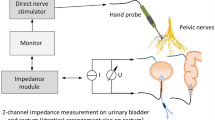PURPOSE
Sexual dysfunction after total mesorectal excision may be caused by injury to the autonomic nerves. During surgery, nerve identification is not always achieved, and, to date, there has been no method to objectively confirm nerve preservation. The aim of this study was to assess the efficacy of a nerve-stimulating device (CaverMap®) to assist in the intraoperative identification of the autonomic nerves during total mesorectal excision, and objectively confirm nerve preservation after proctectomy is completed.
PATIENTS AND METHODS
Sexually active consecutive male patients undergoing total mesorectal excision were prospectively enrolled in this study. During pelvic dissection, the surgeon attempted to localize the hypogastric and cavernous nerves. Cavermap® was used to confirm these findings and to facilitate the identification in cases of uncertainty. At the completion of proctectomy, the nerves were restimulated to ensure preservation. Factors that could affect the surgeon’s ability to localize the nerves and Cavermap® to confirm this were evaluated.
RESULTS
Twenty-nine male patients with a median age of 58 years were enrolled in this study. An attempt to visualize the hypogastric nerves during dissection was made in 26 patients; the surgeon was able to identify the nerves in 19 (73 percent) patients. Cavermap® successfully identified the nerves in six of the seven remaining patients, and failed to identify them in only one case. An attempt to localize the cavernous nerves during dissection was made in 13 patients, of which localization was successful in 8 (61.5 percent) patients. Cavermap® improved the identification rate in four of the remaining five patients. After proctectomy, Cavermap® successfully confirmed the preservation of both hypogastric and cavernous nerves in 27 of 29 (93 percent) patients. A history of previous surgery statistically correlated with failure to identify the hypogastric nerves by the surgeon (P = 0.005). There were no adverse events related to use of the device.
CONCLUSION
Cavermap® may be a useful tool to facilitate identification of the pelvic autonomic nerves during total mesorectal excision and to objectively confirm nerve preservation.



Similar content being viewed by others
REFERENCES
K Havenga CP Maas MC DeRuiter K Welvaart JB Trimbos (2000) ArticleTitleAvoiding long-term disturbance to bladder and sexual function in pelvic surgery, particularly with rectal cancer Semin Surg Oncol 18 235–43 Occurrence Handle10.1002/(SICI)1098-2388(200004/05)18:3<235::AID-SSU7>3.0.CO;2-7 Occurrence Handle1:STN:280:DC%2BD3c3itFKhsw%3D%3D Occurrence Handle10757889
J Tiainen M Matikainen KM Hiltunen (1999) ArticleTitleIleal J-pouch–anal anastomosis, sexual dysfunction, and fertility Scand J Gastroenterol 34 185–8 Occurrence Handle1:STN:280:DyaK1M3gs1CitA%3D%3D Occurrence Handle10192198
CP Maas Y Moriya WH Steup GM Kiebert WM Kranenbarg CJ Velde Particlevan de (1998) ArticleTitleRadical and nerve-preserving surgery for rectal cancer in the Netherlands: a prospective study on morbidity and functional outcome Br J Surg 85 92–7 Occurrence Handle10.1046/j.1365-2168.1998.00530.x Occurrence Handle1:STN:280:DyaK1c7itl2ntw%3D%3D Occurrence Handle9462393
RJ Heald EM Husband RD Ryall (1982) ArticleTitleThe mesorectum in rectal cancer surgery-the clue to pelvic recurrence? Br J Surg 69 613–3 Occurrence Handle1:STN:280:BiyD38zpsVU%3D Occurrence Handle6751457
K Havenga WE Enker (2002) ArticleTitleAutonomic nerve preserving total mesorectal excision Surg Clin North Am 82 1009–18 Occurrence Handle10.1016/S0039-6109(02)00044-0 Occurrence Handle12507206
L Klotz J Heaton M Jewett et al. (2000) ArticleTitleA randomized phase 3 study of intraoperative cavernous nerve stimulation with penile tumescence monitoring to improve nerve sparing during radical prostatectomy J Urol 164 1573–8 Occurrence Handle1:STN:280:DC%2BD3M%2FjtFGqsA%3D%3D Occurrence Handle11025707
Orkin BA. Rectal carcinoma: treatment. In: Beck DE, Wexner SD, eds. Fundamentals of anorectal surgery. New York: McGraw-Hill, 1992:260-370.
NK Kim TW Aahn JK Park et al. (2002) ArticleTitleAssessment of sexual and voiding function after total mesorectal excision with pelvic autonomic nerve preservation in males with rectal cancer Dis Colon Rectum 45 1178–85 Occurrence Handle12352233
T Junginger W Kneist A Heintz (2003) ArticleTitleInfluence of identification and preservation of pelvic autonomic nerves in rectal cancer surgery on bladder dysfunction after total mesorectal excision Dis Colon Rectum 46 621–8 Occurrence Handle10.1007/s10350-004-6621-2 Occurrence Handle1:STN:280:DC%2BD3s3msFWmtw%3D%3D Occurrence Handle12792438
HL Kim DS Stoffel DA Mhoon CB Brendler (2000) ArticleTitleA positive CaverMap response poorly predicts recovery of potency after radical prostatectomy Urology 56 561–4 Occurrence Handle1:STN:280:DC%2BD3cvmslelsA%3D%3D Occurrence Handle11018602
NN Hanna J Guillem A Dosoretz E Steckelman BD Minsky AM Cohen (2002) ArticleTitleIntraoperative parasympathetic nerve stimulation with tumescence monitoring during total mesorectal excision for rectal cancer J Am Coll Surg 195 506–12 Occurrence Handle10.1016/S1072-7515(02)01243-7 Occurrence Handle12375756
Author information
Authors and Affiliations
Corresponding author
Additional information
An erratum to this article is available at http://dx.doi.org/10.1007/s10350-005-0224-4.
About this article
Cite this article
da Silva, G., Zmora, O., Börjesson, L. et al. The Efficacy of a Nerve Stimulator (Cavermap®) to Enhance Autonomic Nerve Identification and Confirm Nerve Preservation During Total Mesorectal Excision. Dis Colon Rectum 47, 2032–2038 (2004). https://doi.org/10.1007/s10350-004-0718-5
Published:
Issue Date:
DOI: https://doi.org/10.1007/s10350-004-0718-5




